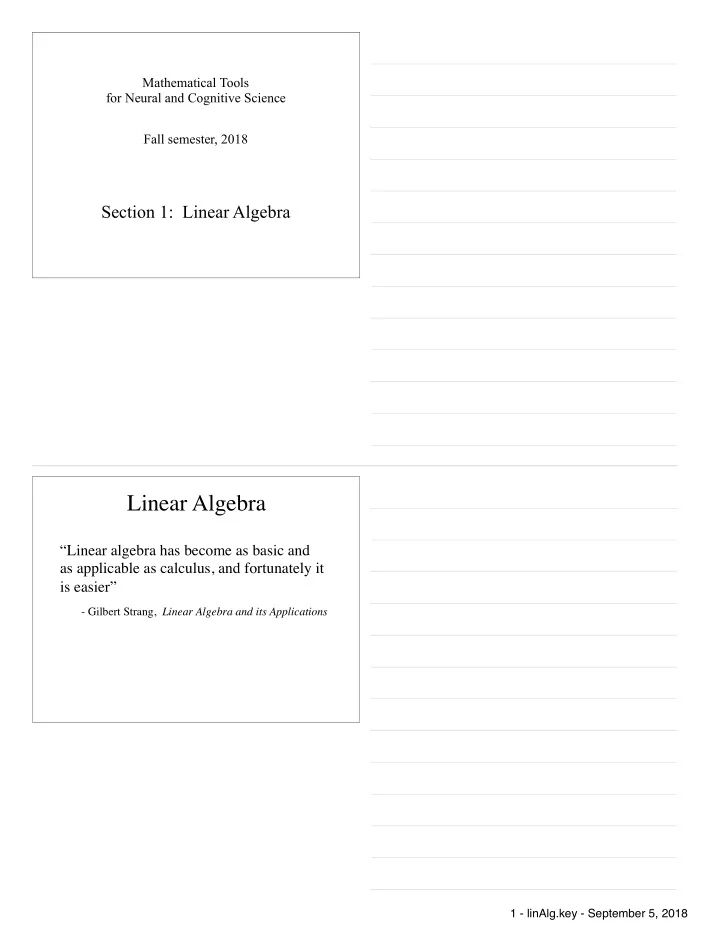

Mathematical Tools for Neural and Cognitive Science Fall semester, 2018 Section 1: Linear Algebra Linear Algebra “Linear algebra has become as basic and as applicable as calculus, and fortunately it is easier” - Gilbert Strang, Linear Algebra and its Applications 1 - linAlg.key - September 5, 2018
Vectors Vector operations • scalar multiplication • addition, vector spaces • length, unit vectors • inner product (a.k.a. “dot” product) - properties: commutative, distributive - geometry: cosines, orthogonality test [on board: geometry] 1 - linAlg.key - September 5, 2018
Vectors as “operators” • “averager” • “windowed averager” • “gaussian averager” • “local differencer” • “component selector” [on board] Inner product with a unit vector v ( . ) • projection ^ u ^ v u ^ u • distance to line • change of coordinates [on board: geometry] 1 - linAlg.key - September 5, 2018
Linear System is a linear system if (and a x only if) it obeys the principle of superposition: S + y b For any input vectors , S a x and any scalars , the two diagrams at the right + must produce the same S response: y b Linear Systems • Very well understood (150+ years of effort) • Excellent design/characterization toolbox • An idealization (they do not exist!) • Useful nevertheless: “All models are wrong… but some are useful.” – George E.P. Box - conceptualize fundamental issues - provide baseline performance - good starting point for more complex models 1 - linAlg.key - September 5, 2018
Implications of Linearity Input Output v L v 1 x v 1 x v 2 x v 2 x L v 3 x v 3 x v 4 x v 4 x Output Implications of Linearity Input Output v L v 1 x v 1 x v 2 x v 2 x L v 3 x v 3 x v 4 x v 4 x “impulse” vectors Output “standard basis” “axis vectors” 1 - linAlg.key - September 5, 2018
Implications of Linearity Input Output v L v 1 x v 1 x v 2 x v 2 x L L v 3 x v 3 x v 4 x v 4 x “impulse vectors” “impulse responses” Output “axis vectors” “standard basis” Response to any input can be predicted from responses to impulses This defines the operation of matrix multiplication Matrix multiplication • Two interpretations of (see next slide): M ~ v - input perspective: weighted sum of columns (from diagram on previous slide) - output perspective: inner product with rows • transpose A T , symmetric matrices ( A = A T ) • distributive property (directly from linearity!) • associative property - cascade of two linear systems defines the product of two matrices • generally not commutative ( AB ≠ BA ), but note that (AB) T = B T A T [details on board] 1 - linAlg.key - September 5, 2018
input perspective: output perspective: weighted sum of columns dot product with rows M ~ M ~ v v Matrix multiplication: dimensional consistency = 1 - linAlg.key - September 5, 2018
All matrices Orthogonal matrices • square shape (dimensionality-preserving) • rows are orthogonal unit vectors • columns are orthogonal unit vectors • performs a rotation of the vector space (with possible axis inversion) • preserve vector lengths and angles (and thus, dot products) y t I i • inverse is transpose t x n i e r t d a I m Diagonal matrices • arbitrary rectangular shape • all off-diagonal entries are zero • squeeze/stretch along standard axes • if non-square, creates/discards axes • inverse is diagonal, with inverse of non-zero diagonal entries of original Singular Value Decomposition (SVD) • can express any matrix as M = U S V T “rotate, stretch, rotate” - columns of V are basis for input coordinate system - columns of U are basis for output coordinate system - S rescales axes, and determines what gets through • interpretation as sum of “outer products” • non-uniqueness (permutations, sign flips) • nullspace and rangespace • inverse and pseudo-inverse [details on board] 1 - linAlg.key - September 5, 2018
SVD geometry (in 2D) Consider applying M to four vectors (colored points) M = U S V T rotate stretch rotate V T S U (note order of transformations!) X X v T v T � � � � M ~ w = s k ~ k ~ w u k = ~ s k u k ~ ~ w ~ k k k “singular values” M U S V T } s 1 s 2 s 3 = (all zeros) } orthogonal basis for input space orthogonal basis for output space 1 - linAlg.key - September 5, 2018
M U S V T s 1 s 2 } 0 (all zeros) = } orthogonal basis for “null space” orthogonal basis for “range space” M U S V T s 1 } 0 (all zeros) 0 = } orthogonal basis for “null space” orthogonal basis for “range space” 1 - linAlg.key - September 5, 2018
Recommend
More recommend